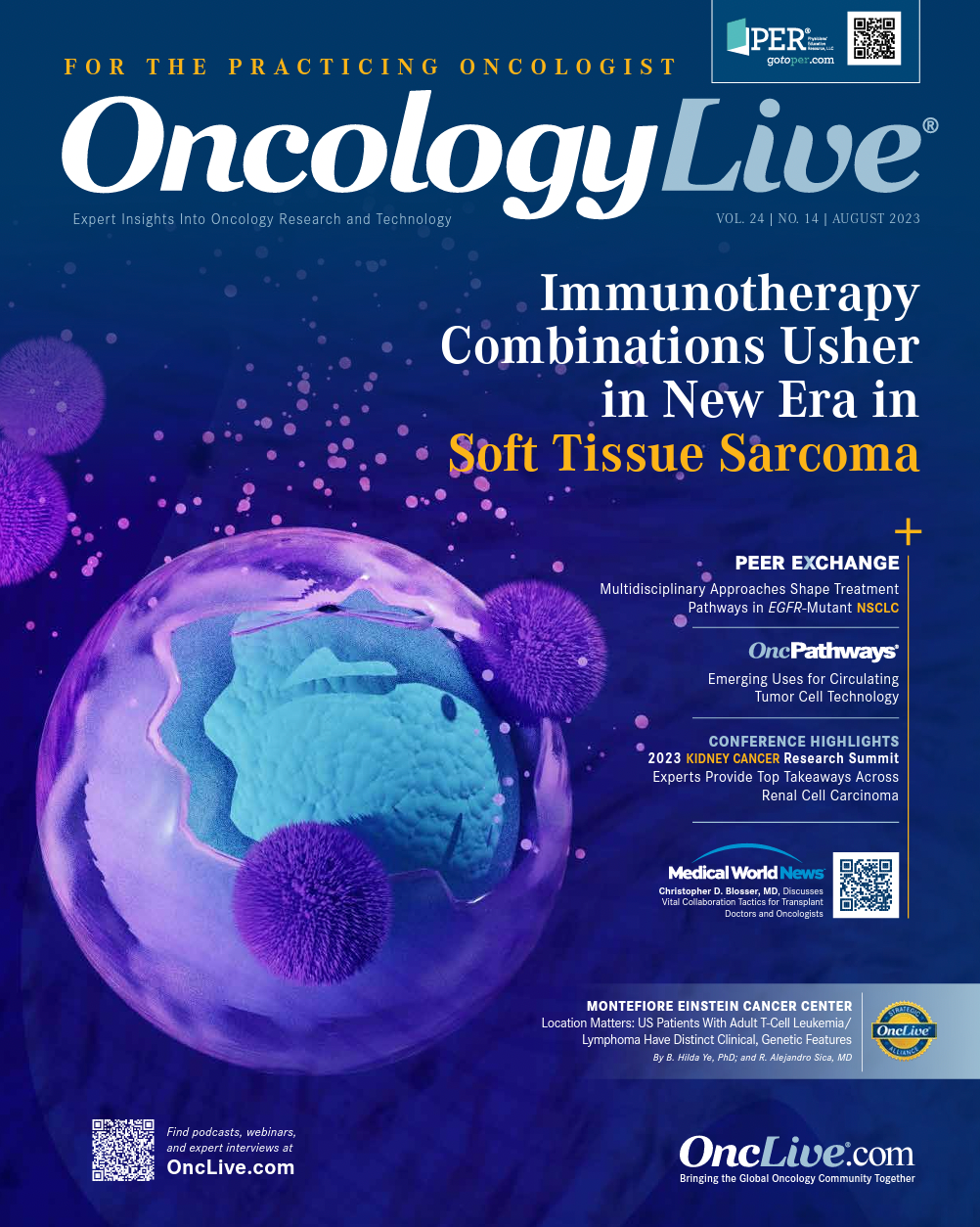Publication
Article
Location Matters: US Patients With Adult T-Cell Leukemia/Lymphoma Have Distinct Clinical, Genetic Features
Author(s):
Adult T-cell leukemia/lymphoma is a rare and very aggressive T-cell neoplasm with an extremely poor prognosis. It is also the only human cancer caused by a retrovirus—human T-cell leukemia virus.
B. Hilda Ye, PhD

Adult T-cell leukemia/lymphoma (ATLL) is a rare and very aggressive T-cell neoplasm with an extremely poor prognosis.1 It is also the only human cancer caused by a retrovirus—human T-cell leukemia virus (HTLV-1). This virus, which is often found in the blood, lymph nodes, and skin, is endemic in southwest Japan (prevalence up to 37%), Sub-Saharan Africa, South America, the Caribbean region, and certain areas in the Middle East and Australia. Worldwide, 15 to 20 million individuals are infected with HTLV-1. Although the prevalence of HTLV-1 infection in the United States is low (< 1%), it is observed in the New York and Florida metropolitan areas, where high numbers of Caribbean immigrants reside.2
Montefiore Einstein Cancer Center (MECC) is located in the Bronx, New York, which is one of the most racially and ethnically diverse counties in the United States. Up to 55% of the population is Hispanic, with the large majority being of Caribbean descent. Given this makeup, MECC treats more patients with ATLL than most medical centers in the United States. We were among the first to conduct an ATLL epidemiology study in the United States, to report that approximately 60% of ATLL cases (approximately 150 cases annually) are diagnosed in immigrants of Caribbean descent, and that the ATLL survival rates are dramatically different among race/ethnicity groups.2 Results showed that non-Hispanic Black and non-Hispanic Asian or Pacific Islander patients experience worse survival outcomes relative to Hispanic and non-Hispanic White patients.2 Recently, our research team was awarded a 5-year, $2.5 million grant from the National Cancer Institute to study the underlying molecular causes of ATLL. To date, there are limited treatment options for this disease.3 In better understanding the underlying basis for differences in incidence and outcome, we hope to identify more effective targeted treatments.
Paths to Understanding
In 1980, Robert C. Gallo, MD, and colleagues at the National Institutes of Health first identified HTLV-1 in a patient with mycosis fungoides, an illness in which lymphocytes become cancerous and directly affect the skin. This patient was later diagnosed with ATLL lymphoma.4 HTLV-1 can cause 2 devastating and lethal diseases after decades of asymptomatic latent infection.2,5
R. Alejandro Sica, MD

Although the medical community has known about ATLL since the 1980s, questions persist regarding the underlying causes of ATLL,6,7 such as the role of key HTLV-1 oncoproteins, the contribution of the dynamic interaction between virus-infected CD4 T cells and host immunity, and the involvement of various driver mutations.
HTLV-1 infection is highly prevalent in Japan, where ATLL accounts for 25% of all peripheral T-cell lymphomas compared with only 2% to 3% in the United States.8 Of note, Japan is the only developed country that has a sizable level of new ATLL diagnoses (approximately 2000 annually). Not surprisingly, most molecular and clinical studies of ATLL originated in Japan, where a high priority has been placed in understanding the disease. In sharp contrast, the United States research community has only recently focused attention on ATLL.9-11
Evaluating Treatment Options
Clinical differences between the Japanese ATLL (J-ATLL) and the variant diagnosed in North America (NA-ATLL) began to emerge after 2010.9 There is now growing evidence that patients in the United States with NA-ATLL are diagnosed at a significantly younger age compared with patients with J-ATLL, at a median of 50 and 58 years, respectively. Moreover, a larger proportion of patients with J-ATLL receive a diagnosis of aggressive subtypes (92% vs 78% for J-ATLL and NA-ATLL, respectively) and present with more comorbidities, such as pulmonary disease and diabetes. New evidence demonstrates significant differences of patients with NA-ATLL vs J-ATLL when it comes to the effectiveness of treatment strategies, both conventional and experimental.11-13
Given the rarity of this disease, randomized trials are unlikely to occur. In most cases, treatment strategies for T-cell lymphomas were developed based on B-cell lymphoma regimens. In the United States, acute forms of ATLL are treated with interferon and antivirals, as pioneered by Ali Bazarbachi, MD, PhD, of the American University of Beirut; and Juan C. Ramos, MD, of the University of Miami Health System. Approximately 50% of patients will achieve a complete remission, and this treatment is now incorporated in the National Comprehensive Cancer Network guidelines. The lymphoma form of this disease is treated with multiagent cytotoxic chemotherapy regimens, such as EPOCH.
Approximately 40% to 50% of patients will achieve a complete remission and can proceed to an allogeneic bone marrow transplant (BMT), which is the only therapy that can provide durable remission. However, BMT is only suitable for a small percentage of patients who can achieve a deep enough response to first-line treatment. Other chemotherapy regimens, such as CHOP (cyclophosphamide, doxorubicin, vincristine, and prednisolone), are only used when patients are not candidates for more intensive treatment, as they have shown inferior outcomes.
One of the significant challenges with BMT is that the affected patient population is underrepresented in the National Marrow Donor Program and finding a suitable donor can be difficult. The good news is that MECC investigators have significant experience in using matched family donors and alternative donors (such as haploidentical donors). Our team recently reported the largest single-center experience in BMT in the United States.14 Approximately 30% of patients were cured and resumed a fulfilling life, with many of them working full time.
Allogeneic BMT eligibility is also significantly lower among patients with NA-ATLL relative to patients with J-ATLL, first because of their reduced chemotherapy responsiveness and second because of more frequent comorbidities.11 Geographic differences have also been observed in 2 recent clinical trials in which 2 types of immune-based therapies produced opposite results among patients in and outside of Japan.12 These clinical observations highlight an urgent need for in-depth basic science understanding and mechanism-based innovative approaches to clinical management of ATLL in the United States.
In the search for immune-based therapies, we participated in a highly innovative clinical trial using chimeric antigen receptor (CAR) T cells, specifically, healthy donor clustered regularly interspaced short palindromic repeats (CRISPR)-edited T cells. This is the first trial in the world to use such innovative technology developed by CRISPR Therapeutics to treat this disease. To date, remarkable results have been observed in certain patients after only 1 or 2 treatments, and MECC is one of the highest-enrolling centers in this trial.
We are very grateful to CRISPR Therapeutics for their commitment to our population. Moreover, MECC’s R. Alejandro Sica, MD, received the Robert A. Winn Diversity in Clinical Trials Career Development Award (Winn CDA). The Winn CDA is 1 of 2 awards offered by the Robert A. Winn Diversity in Clinical Trials Award Program, announced in November 2020, that aims to train, develop, and mentor more than 580 diverse and community-oriented clinical trialists and medical students by 2027. This award has had a positive effect on our ability to engage underrepresented populations in clinical trials.
Beyond BMTs and CAR T
In addition to BMT and CAR T clinical trials, our team has established an impressive ATLL biobank and developed several NA-ATLL cell lines and patient-derived xenograft models.15 These phenotypically and genetically defined experimental models offer valuable tools to address questions, such as how and why certain somatic mutations drive ATLL development, and to identify which cellular pathways should be targeted.
The MECC ATLL reasearch team reported the findings from the first-ever cohort study investigating the genetic alterations in 30 patients with ATLL in the Bronx.16 The most common mutated genes in this patient cohort include TP53 (26%), EP300 (20%), NOTCH1 (15%), and APC (15%). Compared with J-ATLL cases, the mutation frequency of epigenetic and histone-modifying genes (TET2, EZH2, MED12, PBRM1, DNMT3A, KMT2A, HIST1H1E, SPEN, IDH1, SMARCB1, and ASXL1) was significantly higher (57%) in the Bronx cohort compared with what has been previously reported, and these mutations are associated with worse prognoses. Furthermore, in EP300-mutated ATLL cells, the p53 pathway was compromised and decitabine treatment induced a synthetic lethal phenotype. Findings from this study suggest that different pathogenic mechanisms underlie ATLL diagnoses in Japan and North America, and that a common genetic driver for NA-ATLL is EP300 mutations, which lead to reduced p300 activity.16
It is known that anti–HTLV-1 immune surveillance plays a key role in preventing ATLL development in most asymptomatic HTLV-1 carriers.7 ATLL only appears as a clinical disease when the host anti–HTLV-1 immune response collapses. Thus, the changing relationship between HTLV-1–infected cells and host immunity during the natural history of the disease is another promising area for novel discovery. In an exciting new project, the MECC team is partnering with T-cell biologist and MECC member Gregoire Lauvau, PhD; and Ramos, a leading expert in ATLL experimental therapeutics. Together, we are characterizing the dynamic interactions between ATLL cells and host CD8 T cells at distinct phases of ATLL clinical response. To date, the preliminary findings support the hypothesis that for an ATLL treatment to be most effective, ATLL-induced immunosuppression must be overcome, along with restoration of anti-ATLL CD8+ T cell–effector and memory responses. Insights uncovered from these laboratory efforts could pave the way for novel pathway-targeted and immune-modulatory therapies for patients with ATLL and possibly other types of T-cell malignancies.
Embracing Our Diverse Communities
One of the distinct hallmarks of the Bronx is that it is home to such a racially and ethnically diverse population. We are proud to be among the first to report on the effect of ATLL on our Bronx patient population. Newer studies are focused on developing an HTLV-1 vaccine. In the interim, we are thankful to our incredible collaborators.
The studies described in this article were supported by the MECC and grants from the Dr Louis Sklarow Memorial Fund, the Leukemia and Lymphoma Foundation, and the National Cancer Institute.
References
- Verdonck K, González E, Van Dooren S, Vandamme AM, Vanham G, Gotuzzo E. Human T-lymphotropic virus 1: recent knowledge about an ancient infection. Lancet Infect Dis. 2007;7(4):266-281. doi:10.1016/S1473-3099(07)70081-6
- Shah UA, Shah N, Qiao B, et al. Epidemiology and survival trend of adult T-cell leukemia/lymphoma in the United States. Cancer. 2020;126(3):567-574. doi:10.1002/cncr.32556
- Cook LB, Phillips AA. How I treat adult T-cell leukemia/lymphoma. Blood. 2021;137(4):459-470. doi:10.1182/blood.2019004045
- Poiesz BJ, Ruscetti FW, Gazdar AF, Bunn PA, Minna JD, Gallo RC. Detection and isolation of type C retrovirus particles from fresh and cultured lymphocytes of a patient with cutaneous T-cell lymphoma. Proc Natl Acad Sci U S A. 1980;77(12):7415-7419. doi:10.1073/pnas.77.12.7415
- Futsch N, Mahieux R, Dutartre H. HTLV-1, the other pathogenic yet neglected human retrovirus: from transmission to therapeutic treatment. Viruses. 2017;10(1):1. doi:10.3390/v10010001
- Watanabe T. Adult T-cell leukemia: molecular basis for clonal expansion and transformation of HTLV-1-infected T cells. Blood. 2017;129(9):1071-1081. doi:10.1182/blood-2016-09-692574
- Bangham CR, Cook LB, Melamed A. HTLV-1 clonality in adult T-cell leukaemia and non-malignant HTLV-1 infection. Semin Cancer Biol. 2014;26:89-98. doi:10.1016/j.semcancer.2013.11.003
- Vose J, Armitage J, Weisenburger D; International T-Cell Lymphoma Project. International peripheral T-cell and natural killer/T-cell lymphoma study: pathology findings and clinical outcomes. J Clin Oncol. 2008;26(25):4124-4130. doi:10.1200/JCO.2008.16.4558
- Phillips AA, Shapira I, Willim RD, et al. A critical analysis of prognostic factors in North American patients with human T-cell lymphotropic virus type-1-associated adult T-cell leukemia/lymphoma: a multicenter clinicopathologic experience and new prognostic score. Cancer. 2010;116(14):3438-3446. doi:10.1002/cncr.25147
- Malpica L, Pimentel A, Reis IM, et al. Epidemiology, clinical features, and outcome of HTLV-1-related ATLL in an area of prevalence in the United States. Blood Adv. 2018;2(6):607-620. doi:10.1182/bloodadvances.2017011106
- Zell M, Assal A, Derman O, et al. Adult T-cell leukemia/lymphoma in the Caribbean cohort is a distinct clinical entity with dismal response to conventional chemotherapy. Oncotarget. 2016;7(32):51981-51990. doi:10.18632/oncotarget.10223
- Phillips AA, Fields PA, Hermine O, et al. Mogamulizumab versus investigator’s choice of chemotherapy regimen in relapsed/refractory adult T-cell leukemia/lymphoma. Haematologica. 2019;104(5):993-1003. doi:10.3324/haematol.2018.205096
- Ratner L, Waldmann TA, Janakiram M, Brammer JE. Rapid progression of adult T-cell leukemia-lymphoma after PD-1 inhibitor therapy. N Engl J Med. 2018;378(20):1947-1948. doi:10.1056/NEJMc1803181
- Bazarbachi AH, Reef D, Narvel H, et al. Outcome of stem cell transplantation in HTLV-1-associated North American adult T-cell leukemia/lymphoma. Clin Hematol Int. 2023;5(2-3):78-91. doi:10.1007/s44228-023-00032-y
- Chung EY, Mai Y, Shah UA, et al. PAK kinase inhibition has therapeutic activity in novel preclinical models of adult T-cell leukemia/lymphoma. Clin Cancer Res. 2019;25(12):3589-3601. doi:10.1158/1078-0432.CCR-18-3033
- Shah UA, Chung EY, Giricz O, et al. North American ATLL has a distinct mutational and transcriptional profile and responds to epigenetic therapies. Blood. 2018;132(14):1507-1518. doi:10.1182/blood-2018-01-824607










